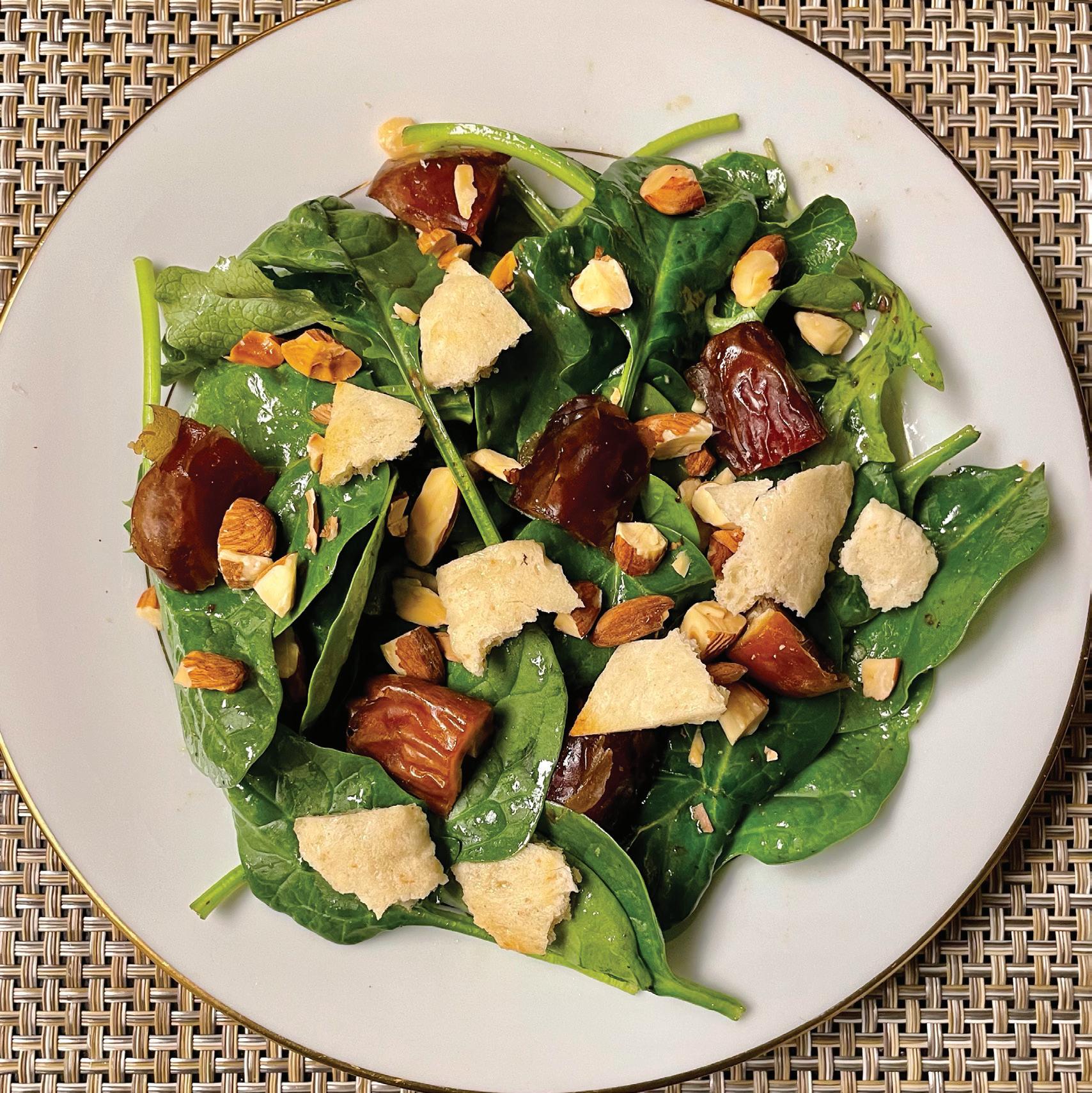
16 minute read
The ‘watchful’ ALMOND: GOOD, & good for you
BY MARGI LENGA KAHN | SPECIAL TO THE JEWISH LIGHT
Almonds play a special role in the Torah. Indeed, other than pistachios, they are the only nuts mentioned in the Torah. And not just once but multiple times.
Advertisement
For example, in Exodus 25:32, God directs Moses to have the Children of Israel build a sanctuary. Among the specifics for the sanctuary are directions for the creation of a gold menorah: “There should be three cups made like almond blossoms in one branch, a knop and a flower; and three cups made like almond blossoms in the other branch, a knop and a flower.”
Native to Israel, almond trees date back thousands of years. They are the first fruit trees to bloom, and they do so before spring arrives. And before the leaves appear, these trees produce fragrant and beautiful flowers.
Bitter almond trees, the oldest ones, produce nuts that contain a poisonous acid called HCN. To make them edible, these bitter almonds must undergo a process to remove that deadly acid. The resulting nut meat, with its concentrated flavor, is the key ingredient in almond extract.
Recipes
• Lemony Spinach, Date & Almond Salad
• Almond & Pistachio Lemon Tea Bread
• Almond Tahini Dip
There are two species of almond trees: cultivated almond trees and bitter almond trees. The cultivated variety, the majority of which are now grown in California, are the ones we delight in eating. The skins of these almonds are edible; however, for baking purposes, many people prefer to use blanched almonds, which are almonds that have had their skins removed. You can purchase blanched almonds at some ethnic markets, or you can do it yourself. Simply place almonds in a pot of boiling water for one minute, rinse them in cold water, and then slip off the skins.
Almonds have been an indispensable ingredient in cuisines the world over and are used in many foods we associate with those cuisines. For example, Greek skordalia, a sauce made from almonds and potatoes, is frequently served with fish and vegetables or as a dip. So, too, Spanish ajo blanco, made with almonds, bread and garlic, is the original gazpacho, created long before tomatoes made their way to Spain from the new world. And macarons, the French “rainbow” sandwich cookies, are made with almonds and egg whites.
Sephardic cuisine includes almonds in many main dishes and desserts. For example, there’s the Sephardic almond sauce bademli, which is made from a mixture of water, almonds and parsley and used to top a variety of meat and fish dishes. There is also almond baklava; fnaro, a honey-sweetened egg custard; travados, an almond and currant filled pastry; and other such dishes featuring or incorporating this ancient tree nut.
So, too, almonds are plentiful is Ashkenazi cuisine, including the iconic mandelbrodt (“mandel” is Yiddish for “almond”); almond milk, which long predated the current health craze; kifli, ground almond cookies in a crescent shape; rolled cakes with an almond filling; haroset for Passover; and those delicious dumplings for chicken soup that include finely chopped almonds in an egg and matzah meal mixture.
The Hebrew word for almonds is shakeid, which means “watchful.” It is symbolic for God’s watchfulness over the Jewish people. For many cultures, almonds are a symbol of hope, happiness and renewal. For example, at many Jewish weddings, newlyweds are showered with almonds as they leave the chuppah. Jordan almonds, the pastel candy-coated almonds, are frequently given out as a traditional wedding party treat at many Jewish and Greek wedding receptions.
There are so many ways to enjoy almonds: out of hand, ground into milk, almond butter, marzipan, almond paste, frangipane
LEMONY SPINACH, DATE & ALMOND SALAD
INGREDIENTS:
Vinaigrette:
3 tbsp. red wine vinegar
2 tbsp. honey
1 tsp. finely grated lemon zest
2 tbsp. freshly squeezed lemon juice, plus more to taste
1 tsp. Dijon mustard
½ small shallot, peeled and finely minced
½ c. extra virgin olive oil, plus more as needed
Pinch of crushed red chili flakes (optional)
Coarse kosher salt, to taste
Fresh ground black pepper, to taste
Salad:
12 oz. fresh baby spinach, rinsed and spun dry
6 Medjool dates, pitted and cut into strips number of exciting culinary creations.
Besides being delicious, almonds pack a wallop of nutritional benefits. In their beautiful book “Almonds,” my friend Barbara Bryant and her co-author Betsy Fentress identify almonds as a superfood: “Compared to other tree nuts, they rank first in protein, fiber, calcium, vitamin E, riboflavin and niacin. Plus, they deliver another startling property: Even though a 1 ounce (30 g) serving has 160 calories, the body absorbs only 129 of those calories.”
So, what are you waiting for? Grab a handful of almonds to snack on. Or, for a more elaborate snack, stuff an almond inside a pitted date. Or sprinkle a large handful of chopped almonds on top of your favorite salad, hot grain dish or
Passionate Palate
Margi Lenga Kahn is the mother of five and grandmother of nine. While teaching virtual cooking classes and preparing meals for the local Meals On Wheels program, she continues to work on a project to preserve the stories and recipes of heritage cooks. She welcomes your comments and suggestions at margikahn@gmail.com.

¾ c. unsalted almonds, toasted, cooled and coarsely chopped
2 pita breads split in half, br`shed with olive oil, lightly salted, toasted in the oven until crisp, and torn into 1-in. pieces
DIRECTIONS:
1. For vinaigrette, whisk together vinegar, honey, lemon zest, lemon juice, Dijon mustard and minced shallot.
2. Drizzle in ½ c. of olive oil while whisking until dressing has emulsified. Add crushed chili flakes (if using) and salt and pepper to taste and whisk again.
3. Whisk in additional lemon juice, salt and pepper to taste. Set aside.
4. Place spinach in a large salad bowl.
5. Add dates, almonds and pita pieces to spinach and toss to combine.
6. Drizzle two-thirds of the vinaigrette evenly over the salad and toss well.
7. Taste, adding more vinaigrette and salt and pepper as needed.
Makes 6-8 side salad servings.
Almond Tahini Dip

(Adapted from a recipe by chef Barak Yhezkeli, Galilee Culinary Institute)
Tahini sauce gets a new look here with almond flour standing in for the traditional sesame seed paste. The texture is different from tahini sauce, but the flavor is addictive.
INGREDIENTS:
1 c. almond flour
¾ c. grape seed oil or sunflower oil
1 small garlic clove, peeled and chopped
1 tsp. za’atar, or more to taste (you could substitute a mixture of dried thyme and sumac if you have it)
¼ tsp. coarse kosher salt, plus more to taste
1 tbsp. freshly squeezed lemon juice, plus more to taste
Freshly ground black pepper, to taste
Cold water as needed to achieve desired consistency
Fresh chopped parsley or mint, for garnishing
Pita chips and carrot sticks, for serving
DIRECTIONS: roasted chicken.
1. Place almond flour in a blender. Turn on the blender and slowly drizzle oil through the lid. Add garlic, za’atar, salt, lemon juice and black pepper. Process again, adding cold water, if necessary, to reach the consistency of a dip.
2. Transfer dip to a bowl and garnish with chopped parsley or mint.
3. Serve with pita chips and carrot sticks.
Another idea: Make dukkah (an Egyptian nut and seed condiment). It’s easy. Combine a half cup each of almonds and pistachios in a small food processor. Pulse to finely chop. Add 1 tablespoon each of sesame seeds and poppy seeds and a half tablespoon each of toasted cumin seeds, fennel seeds and coriander seeds. Pulse to combine and add a bit of salt to taste. Store in a jar at room temperature and use it to garnish or add pizzazz to soups, salads, roasted vegetables and your favorite hummus.
Below are a few other delicious recipes using this ancient but delicious tree nut.
Bon Appetit!
Almond And Pistachio Lemon Tea Bread

This is a light and not-too-sweet cake that’s made in a standard loaf pan. It’s perfect alongside a cup of coffee or tea.
INGREDIENTS:
Bread:
1 c. superfine sugar (225 g.) (C&H Baker’s Sugar- available at major supermarkets)
1¼ c. (125 g.) unsalted shelled pistachios
2 sticks + 1½ tbsp. (250 g.) unsalted butter, plus more for oiling pan Finely grated zest of 1 large lemon
1 tsp. vanilla extract or vanilla bean paste
4 large eggs
1 c. (100 g.) almond flour (finely ground almonds)
1 c. (125 g.) all-purpose flour
1 tsp. baking powder
¼ tsp. coarse kosher salt or fine sea salt
Glaze:
1 c. powdered sugar
2 tbsp. freshly squeezed lemon juice (thick drizzling consistency) plus more as needed
Finely grated zest of 1 medium lemon
DIRECTIONS:
1. Position a rack in the center of the oven and preheat to 325 degrees. Butter an 8½ by 4 ½ inch loaf pan. Line the bottom of the pan with a strip of parchment paper and butter paper; set aside.
2. Measure out 1 c. of sugar. Remove 1 tbsp. of the sugar and add it, along with the pistachios, into a food processor. Process until ground, and then pulse five or six times until the nuts are finely ground, stopping before the nuts turn into a butter; set aside.
3. In the bowl of a stand mixer fitted with a paddle attachment, add the remaining sugar, all the butter, lemon zest and vanilla; cream together until light and fluffy, about two minutes, stopping once or twice to scrape the bottom and sides of the bowl.
4. Add the ground pistachio mixture and eggs to the mixer.
5. In a medium bowl, whisk together almond flour, all-purpose flour, baking powder and salt. Pour the mixture over the eggs and mix everything together on low just until ingredients are thoroughly combined and batter is light.
6. Place pan in oven and bake for 55-65 minutes, or until a toothpick inserted in the center of the bread comes out clean. Transfer pan to a cooling rack for five minutes. Carefully loosen the bread from the sides of the pan with a sharp knife. Turn bread out onto the cooling rack and let cool for another 10 minutes.
7. While bread cools, whisk together all the glaze ingredients in a medium bowl until smooth. Place a sheet of parchment or wax paper under the cooling rack to catch excess glaze. Drizzle glaze over bread and let cool to room temperature before slicing.
Makes 1 tea bread.
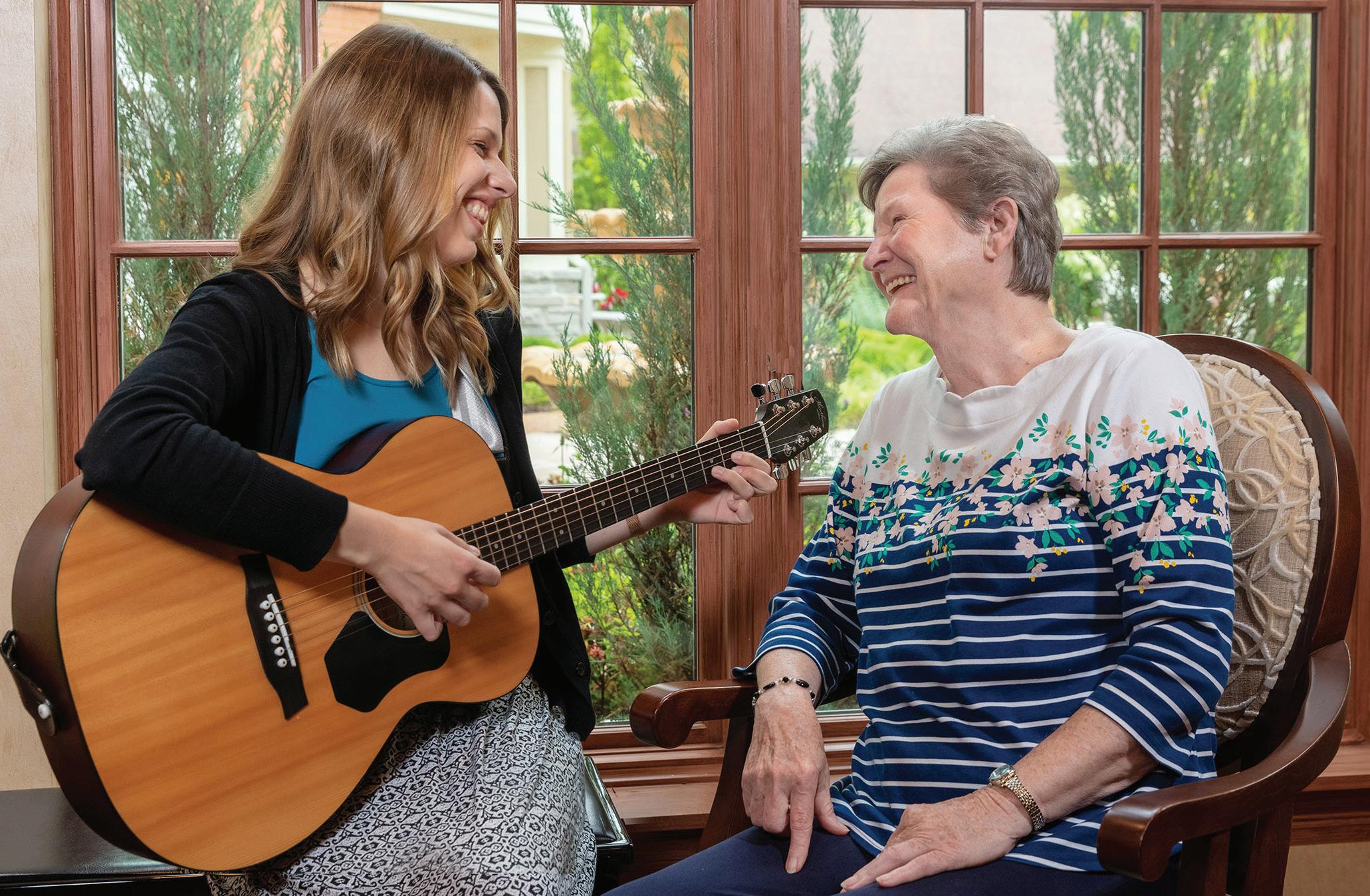
BY BILL
MOTCHAN | SPECIAL TO THE JEWISH LIGHT
In September, Zachary Wexelman was strumming a guitar in his music studio when he received an email from Universal Music Group. The company’s A&R (artist & repertoire) team wanted to license a song Wexelman wrote. That’s the same Universal whose publishing group artists include Taylor Swift, Drake, Elton John, Billy Joel, Bob Dylan, Billie Eilish and Justin Bieber.

For Wexelman, 33, it was the culmination of a dream he’s had since attending middle school in Clayton. A career in the music industry has always been his goal. After years of grinding and honing his craft, the call from Universal came in large part through his online presence on the short-form video sharing app TikTok.
“I had one TikTok tutorial that went viral with over 3 million views, and that’s how I got this deal,” Wexelman said. “Initially I thought, ‘This has to be a scam,’ but it turned out it was real. It was a long process. There’s a lot of bureaucracy involved with these big labels. They licensed the song, and now I’m trying to leverage it into a deal or another song. It’s a start.”
“Insecurities” is the song licensed by Universal, an original composition Wexelman wrote and performed under his stage name Real Topeka People. It’s one of several pop tunes he created that are available for download from Amazon Music and the iTunes Store. The TikTok video that boosted his musical credibility is called “How to Make Indie Dance Music in 60 Seconds” (online at https://bit.ly/indie-dance-music or view the full, finished audio on YouTube at youtu.be/3-Wyxgmy4MY.
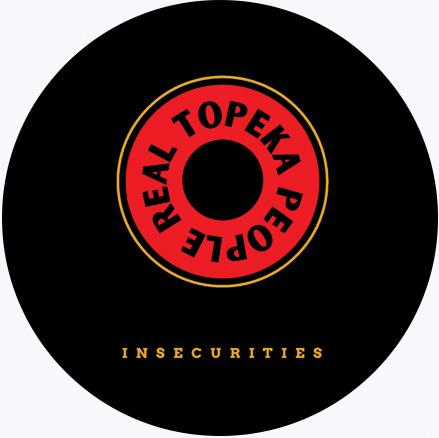
TikTok is also where you’ll find a wide range of Wexelman videos, many of which are music how-tos, covering every genre from hip-hop to disco. His TikToks take a wry look at the music business from the perspective of an artist who spent a decade in Los Angeles trying to break out. He even posted a 36-second summary of his success story, “How I Managed to Sign a Deal With Universal Music” (online at https://bit.ly/universal-deal).

In addition to being a singer-songwriter, Wexelman is a TikTok content creator who has discovered the importance of the social media site for emerging artists. The music business is not like it once was. A&R reps from big labels no longer hang out in music clubs hoping to find new talent. Now they search out the next big thing on YouTube and TikTok.

From humble beginnings
The music journey for Wexelman began in high school, when he had a band with some friends. They played small gigs, but his drive to make it big was always there, says Aaron Cannon, his longtime friend.
“Zach was always the most deeply invested in music,” said
33. “For the rest of us, it was a hobby. He recorded guitar riffs, and he obviously spent hours working on them, and he really had a hunger for it.”
Cannon and Wexelman played soccer and basketball growing up, and they were Hebrew school friends at ’rith Sholom Kneseth Israel. Later, they went on a Birthright trip together.
“As high schoolers, we connected more with Judaism, and that culminated in college, when we went to Israel together,” Cannon said. “It gave us a deep understanding of what Israel was like and what it meant to our culture and background.”
Wexelman, who is now a member of Kol Rinah, graduated from Boston University with a degree in film. After college, he went to L.A. to try his luck in the entertainment industry, which can be a brutal and humbling experience. For 10 years, he worked in video production and dabbled in music. He created a band, the Space Cadets, managed by his college friend Justin Cohen.
“Literally the first time I ever met him I stumbled into his dorm room and funny enough he was playing Nelly’s ‘Ride with Me’ on acoustic guitar,” said Cohen, 32. “That literal second I thought, ‘This kid’s got talent.’ Zach is the most talented person I know musically.”
Cohen now co-hosts a podcast called “Top Fives and Deep Dives” that examines music, film and TV. The podcast’s spirited intro jingle was written by Wexelman.
“The theme song has become quite a staple of the show, and everyone asks me about it,” Cohen said. “I’m glad that Zach is starting to get the recognition he deserves. He’s been working on it for so long. A lot of artists work with songwriters, and the fact that Zach can do it all himself is becoming a rarer and rarer skill in the music industry.”
Wexelman said jingle writing is one more revenue stream for a singer-songwriter who has a knowledge of audio production.
“I write jingles for a company called Songfinch,” he said.
Medical Excellence, Compassionate Care

You want your loved one to get the best memory care available. We know how you feel. That’s why memory care is our primary focus. Parc Provence specialists are experts in their fields and committed to compassionate care. Our Medical Directors are leading specialists in Alzheimer’s disease and geriatric medicine at Washington University School of Medicine. Our residents benefit from the latest in research and best practices, so they can continue to make the best of every day.
Please call to learn more or to schedule a tour.
605 Coeur de Ville Drive, Creve Coeur, MO 63141
“They were written up in zine, and they reached out to me because they’d seen my TikToks. There’s an art to it. You have to try to find that earworm.”
A one-man band
Like Jimi Hendrix and Paul McCartney, Wexelman can’t read music. He plays by ear. It’s entirely possible he inherited his musical talent from his parents. His late father, Joel, played in a band called the Physical Imaginations while a student at University City High School. Wexelman’s mother, Randi Mozenter (board chair of Kol Rinah), is a tal ented pianist.

“My dad played keyboard, and he used to sing me Jewish lullabies,” Wexelman said. “One that stuck with me was ‘Henei Ma Tov.’”
That memory launched Zachary into an impromptu pitch perfect a cappella rendition of the 133 Psalm. His singing voice, guitar chops and mastery of the techni cal aspects of recording enable Wexelman to be a one-man band. It gives him the freedom to create Tik Tok music videos and pop tunes from his basement studio in University City. The setup is more conducive to creativ ity than his former apartment in West Hollywood.
“I came back to St. Louis during the summer of 2020,” he said. “The pandemic was the straw that broke the camel’s back. I had an adversarial relationship in a bottle. Sometimes a guitar riff turns into a memorable Igniting the spark of creativity that generates a hit songs pays called “STL” and was
“I wish I had come back to St. Louis sooner,”
STORY AND PHOTOS
BY BILL MOTCHAN
t. Charles County is home to two dozen churches and zero synagogues. Curiously, about 5,800 Jews live in St. Charles, O’Fallon, St. Wentzville and Cottleville. That translates to roughly 10% of all the Jews in the greater St. Louis region. Those numbers come from a 2014 Jewish Federation of St. Louis study, so there may well be more Jews living west of the Missouri River in 2022. In the eight years since that study was completed, the overall population of St. Charles has increased by

A lack of Jewish worship facilities in St. Charles has not appeared to deter western migration. The 10-lane Veterans Memorial Bridge connecting Maryland Heights to St. Charles via Route 364 created fast access from St. Louis County. More affordable housing is another factor in the choice by many Jewish St. Louisans to migrate to what once seemed the far exurbs.

Mark and Carol Schatz moved to St. Charles County from the Chicago area in 1981. They were teachers looking for new opportunities in a less expensive market, and the Wentzville School District beckoned. It needed the skills they offered. Mark was an art teacher, and Carol taught special education.
Mark had to look up Wentzville on a map to figure out exactly where it was.
“We had a short commute to work, a five-minute drive,” said Schatz, 69. “At that time, the school district was not big, and when a new teacher was hired, the whole faculty threw them a party. It was nice and welcoming. They asked if we had a church — a lot of them didn’t know any other word — because everybody in Wentzville went to a church and they wanted to help us out. That’s how we found out about B’nai Torah.”
The small, now-defunct congregation was a good fit for the Schatzes, and they made friends there and in the community. They raised both of their children in Lake St. Louis and, now retired, they still live there. For most of the years the Schatz children attended school in Wentzville, they were the only Jews in their classes.
“They tell us now they’re glad they had that opportunity,” Schatz said. “They’re glad they learned what it was like to be a minority and got to meet all different kinds of kids and not just kids who were like them.”
Six years ago, Richie and Blair Levin bought a home in St. Charles primarily because it was so affordable. Levin figures the same property in Creve Coeur would have been as much as $150,000 more.
“You get a lot more house for the money,” said Levin, 32. “I also like the ‘newness’ of the houses being built here. And there are a lot of young families. My neighborhood is predominantly a few years older than us with young kids. On
Halloween, we get more than 100 kids trick-or-treating.”
That’s a positive for the Levin family. They have a 2½-year-old son, Logan, and he’ll grow up around other kids his age. He attends preschool at Temple Israel, a short drive from their home.
Levin doesn’t feel isolated as a Jew in St. Charles. Another Jewish family lives down the street, and he has cousins and a number of friends who live in the area. And thanks to the Page Avenue extension, a drive to see family across the Missouri River takes just 15 minutes.
Gerry and Jennifer Nemet lived in Birmingham, Ala., for 17 years. They were familiar with being part of a small Jewish community. Now they live in New Town, the St. Charles County planned community that looks like a quaint New England village. The Nemets got a good vibe about their new home as they were driving up in mid-2020.
“I remember pulling into New Town,” said Nemet, 55. “It was June, and we saw all the pride flags displayed. My son said, ‘You wouldn’t see that in a neighborhood in Alabama.’ It’s just a lot more openminded, balanced place, and we really liked that.”
Nemet said there are challenges to maintaining a Jewish home in St. Charles, but they’re minimal, such as locating a challah at a local grocery. Finding other Jews has not been difficult, though. New Town is a diverse community, and the annual menorah lighting in the town square draws quite a few Jewish residents who can walk there.
The menorah lighting found its audience partly through social media. Brandy Frank created a New Town Havurah event on Facebook so the closeknit Jewish community there could easily find the time and location. Brandy and her husband, Eric, belong to United Hebrew Congregation, a 25-minute drive from their New Town home. The Franks are raising their children with a Jewish identity, which they proudly display.
Eric Frank grew up in University City. His family moved west, and he attended Parkway Schools. He went to Jewish camp and celebrated his bar mitzvah at UH. The decision to move to St. Charles was a financial one for him.

“I basically came to St. Charles because it was affordable,” said Frank, 45. “When I was 25, I couldn’t afford to build a new house in St. Louis County.”
The Franks have a mixed marriage, not unlike other couples in St. Charles. Brandy Frank, 38, grew up in Washington, Mo., and she hadn’t met many Jews before she took a job at

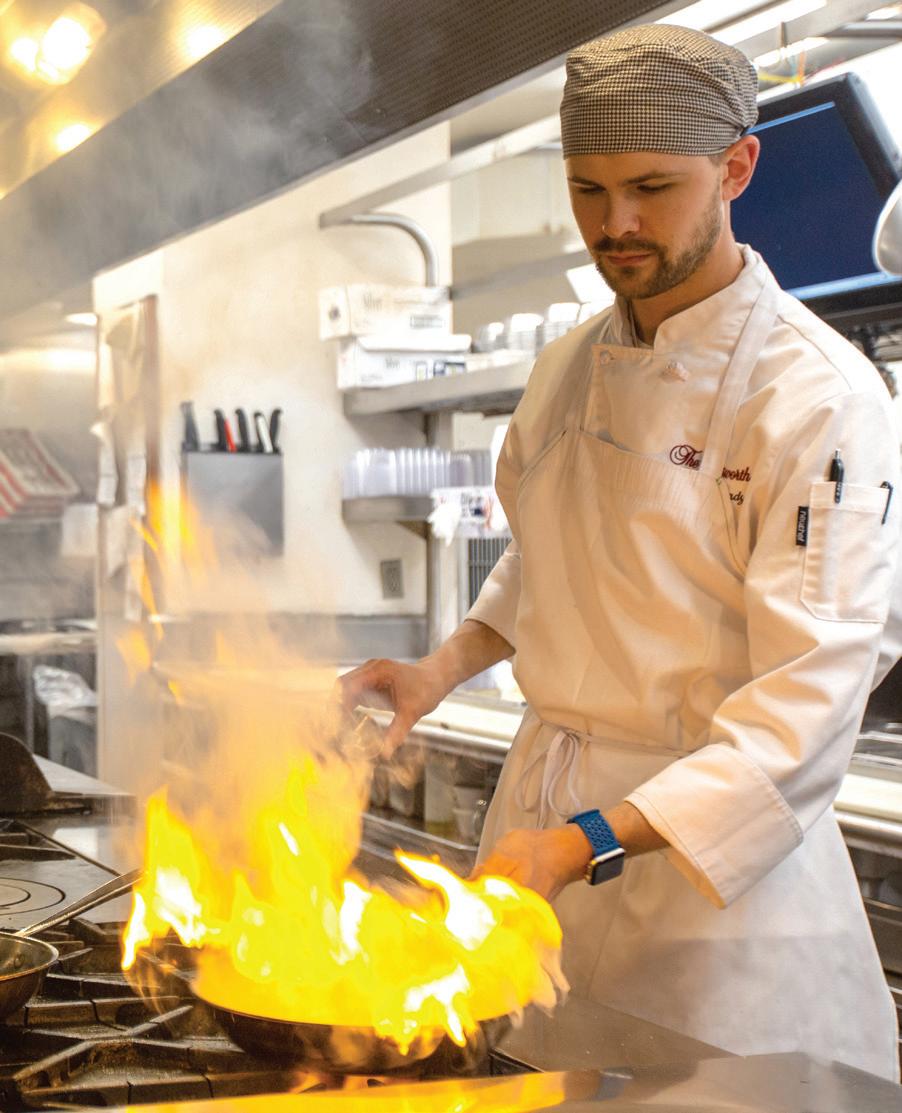
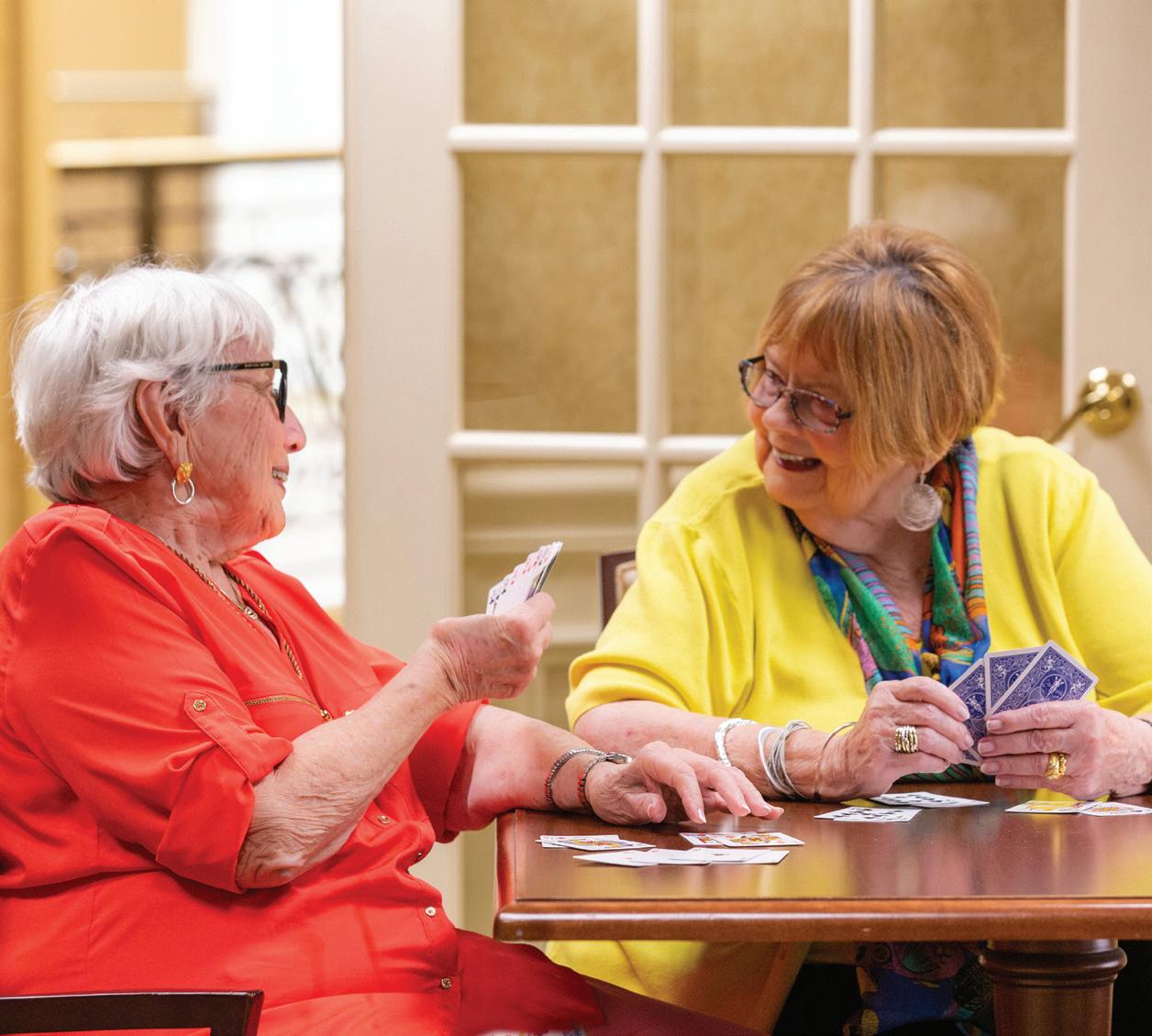




Westwood Country Club, where she met Eric. They were married in a Jewish ceremony, and Brandy makes sure the family celebrates Jewish holidays.
“When I was growing up, my parents didn’t have a faith,” she said. “It’s important for my boys to have a foundation of faith and values.”










